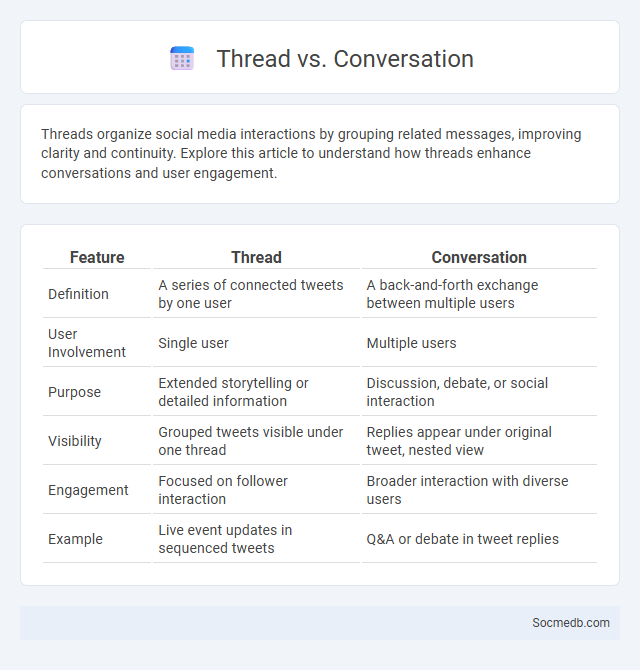
Photo illustration: Thread vs Conversation
Threads organize social media interactions by grouping related messages, improving clarity and continuity. Explore this article to understand how threads enhance conversations and user engagement.
Table of Comparison
| Feature | Thread | Conversation |
|---|---|---|
| Definition | A series of connected tweets by one user | A back-and-forth exchange between multiple users |
| User Involvement | Single user | Multiple users |
| Purpose | Extended storytelling or detailed information | Discussion, debate, or social interaction |
| Visibility | Grouped tweets visible under one thread | Replies appear under original tweet, nested view |
| Engagement | Focused on follower interaction | Broader interaction with diverse users |
| Example | Live event updates in sequenced tweets | Q&A or debate in tweet replies |
Introduction to Threads and Conversations
Threads on social media organize related posts into a cohesive conversation, enhancing user engagement by allowing seamless interaction and easy tracking of discussions. Conversations within threads promote community building and knowledge sharing by enabling participants to reply, comment, and react in a structured manner. This format improves content visibility and user experience by maintaining context and continuity across multiple related messages.
Defining a Thread: Structure and Purpose
A thread on social media is a series of connected posts or messages that expand on a specific topic, enabling detailed discussions and storytelling. Structured sequentially, each post builds upon the previous one, enhancing clarity and engagement for your audience. Understanding this format helps You effectively communicate complex ideas and maintain user interest across multiple interactions.
What Constitutes a Conversation Online?
A conversation online consists of interactive exchanges between users through comments, direct messages, or posts that foster engagement and dialogue. Key elements include responsiveness, relevance, and the use of multimedia content to enhance understanding and emotional connection. Platforms like Twitter, Facebook, and Instagram enable real-time feedback, creating dynamic conversations driven by user participation and algorithmic amplification.
Thread vs. Conversation: Key Differences
Threads organize messages in a linear, hierarchical format allowing users to follow specific topics within social media platforms, while conversations represent fluid, real-time interactions often without structured order. Threads enhance clarity by grouping related comments, making it easier to track detailed discussions on platforms like Twitter or Reddit. Conversations, common on messaging apps and live chats, emphasize immediacy and dynamic exchanges, fostering spontaneous engagement among participants.
Advantages of Threaded Discussions
Threaded discussions on social media enhance user engagement by organizing conversations into clear, context-rich threads, making it easier to follow multiple viewpoints. This structure improves information retention and encourages in-depth dialogue by allowing participants to respond directly to specific comments. Platforms like Reddit and Discord utilize threaded discussions to foster community building and streamline content navigation.
Challenges in Managing Conversations
Managing conversations on social media presents challenges such as handling high volumes of messages, moderating inappropriate content, and addressing diverse user sentiments swiftly. Algorithms and real-time monitoring tools play crucial roles in filtering spam and ensuring relevant interactions reach Your audience. Effective strategies require balancing automated responses with personalized engagement to maintain a positive brand reputation and foster community trust.
Use Cases: When to Use Threads or Conversations
Threads excel in group discussions or collaborative projects where organizing messages by topic enhances clarity and continuity. Conversations work best for private or one-on-one interactions requiring quick, informal exchanges without the need for structured categorization. Choosing between threads and conversations depends on the communication context, user preferences, and the complexity of the information shared.
Threaded Communication in Social Media Platforms
Threaded communication in social media platforms enhances user engagement by organizing conversations into clear, chronological threads. This structure allows Your interactions to be easily followed and referenced, promoting more meaningful exchanges and reducing confusion in group discussions. Platforms like Twitter, Facebook, and Discord leverage threaded messaging to create coherent dialogue streams that improve community interaction and content discovery.
Best Practices for Thread and Conversation Management
Effective thread and conversation management on social media involves timely responses, clear organization, and consistent engagement to maintain audience interest and foster community growth. Utilizing features like tagging, threading, and pinned posts enhances visibility and keeps discussions coherent while minimizing clutter. Monitoring sentiment and addressing concerns promptly helps build trust and encourages meaningful interactions.
Conclusion: Choosing Between Threads and Conversations
Choosing between Threads and Conversations depends on user preferences for content organization and interaction style. Threads excel in maintaining topical focus and clear, linear discussions ideal for in-depth conversations, while Conversations offer a more fluid and dynamic exchange suited for casual and real-time engagement. Evaluating user goals, platform features, and communication needs ensures the optimal social media experience.
 socmedb.com
socmedb.com